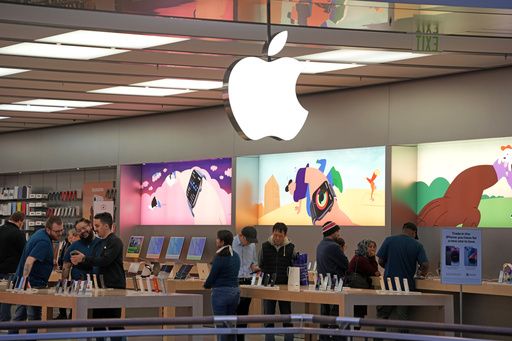Apple’s sales fall for the fourth straight quarter despite a strong start for latest iPhones
FILE – Customers shop in an Apple store in Pittsburgh Jan. 30, 2023. Apple reports earnings on Thursday, Nov. 2, 2023. (AP Photo/Gene J. Puskar, File)
Apple’s sales remained on a downward slope during the summer, resulting in a full year of declining revenue at the technology trendsetter with a long history of steady growth that turned it into the world’s most valuable publicly traded company.
The slight sales deterioration announced Thursday for the July-September period marked the end of Apple’s fiscal year — a stretch that saw the company suffer a revenue decrease from the prior year in each quarter.
Although this past fiscal year’s revenue only dipped by 3% from the previous fiscal year, it was still a noteworthy anomaly in a business that has been so successful that Apple became the first U.S. company to be valued at $3 trillion earlier this year.
It’s the first time Apple’s fiscal year revenue has dropped since 2019 when sales fell by 2%.
Although Apple’s revenue in the latest quarter deceased 1% from last year to $89.5 billion, its profit rose 11% to $22.96 billion, or $1.46 per share. Both figures eclipsed analysts’ projections, according to FactSet Research.
“We continue to face an uncertain macroeconomic environment,” Apple CEO Tim Cook said during a conference call with analyst.
Apple’s stock price fell more than 3% in extended trading after the results came out. The shares have fallen by nearly 10% from their all-time highs reached in July amid worries about the sales slowdown and that China may prohibit purchases of iPhones by government workers amid rising tensions with the U.S., at the same time China’s Huawei rolls out new smartphones that pose tougher competition.
The Cupertino, California, company didn’t fare as well in China as analysts had hoped in the most recent quarter, with revenue in that region declining 2% from the same time last year.
Apple’s overall revenue regression stems largely from the longer periods consumers are holding on to their iPhones in an era of incremental improvements to the newest models, as well as the ongoing pressures on household budgets from still-abnormally high inflation.
“The big question is if this is just a blip, or signs of a bigger shift among consumers as rising interest rates and a weaker economic backdrop discourage consumers from making pricey purchases,” said Investing.com analyst Jesse Cohen.
To help juice its revenue, the tech giant has been raising some of its prices. The starting price for its top-of-the-line iPhone 15 Pro Max unveiled in September is $1,200, a $100 bump from last year’s version of that device. Just last week, Apple raised the prices for several of its subscription products, including its video streaming service, which boosted its monthly fee 43% to $10 per month.
In a bright spot, Apple’s iPhone sales climbed 3% to $43.8 billion — a sign the company’s latest models are being well received heading into the holiday shopping season.
Apple’s service division also turned in a robust quarter with revenue of $22.31 billion, a 16% increase from last year.
A big chunk of that revenue flows from Google, which pays Apple for its search engine to be the automatic option for responding to queries made on the iPhone and the Safari browser — a deal that is now the focal point of an antitrust trial over whether the alliance between the two tech powerhouse stifles competition and innovation.
Evidence submitted during the trial has revealed that Google paid more than $26 billion to Apple and other companies to put its search engine in a privileged position during 2021. Analysts now estimate that Apple, on average, receives somewhere from $4 billion to $5 billion each quarter from Google — a stream of revenue that could evaporate if a judge rules the payments are anticompetitive.
Copyright 2023 The Associated Press. All rights reserved


